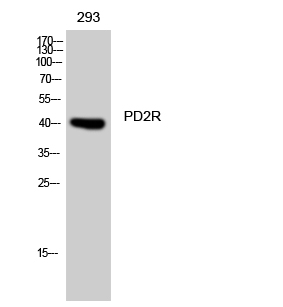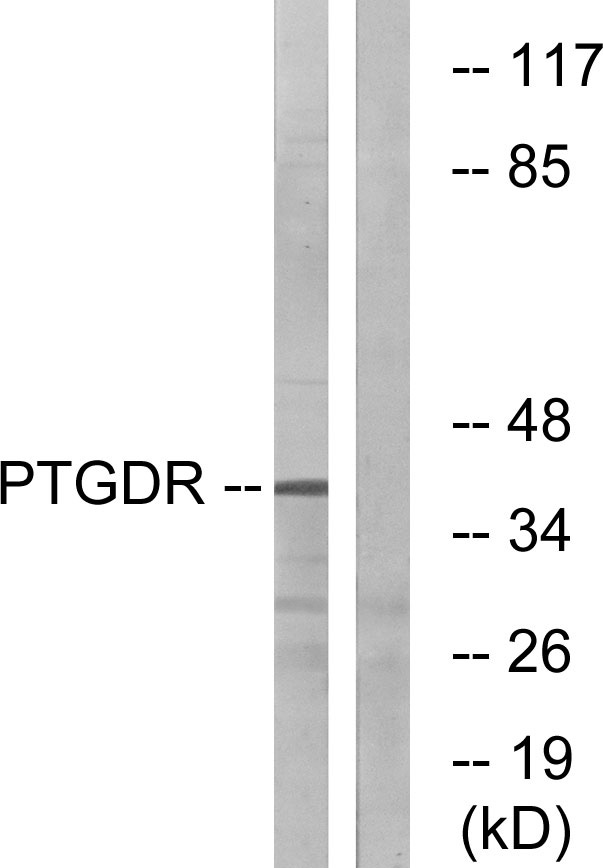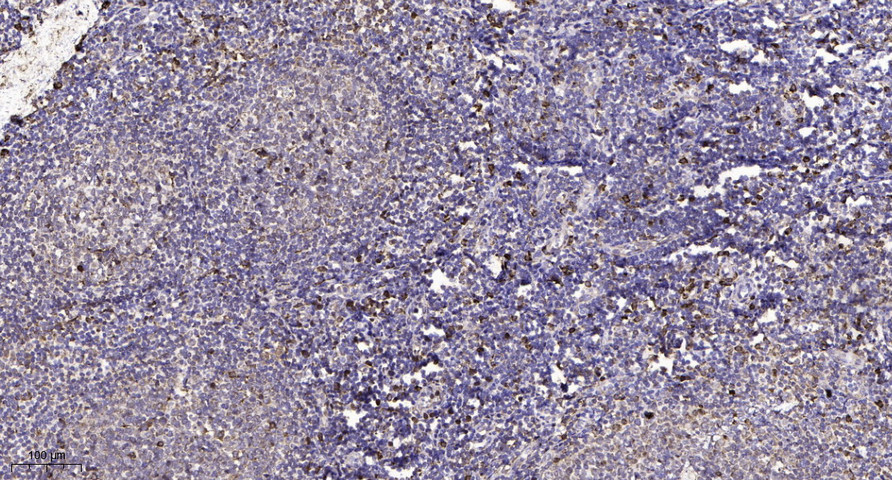PD2R Polyclonal Antibody
- Catalog No.:YT3624
- Applications:WB;IHC;IF;ELISA
- Reactivity:Human;Rat;Mouse;
- Target:
- PD2R
- Fields:
- >>Neuroactive ligand-receptor interaction
- Gene Name:
- PTGDR
- Protein Name:
- Prostaglandin D2 receptor
- Human Gene Id:
- 5729
- Human Swiss Prot No:
- Q13258
- Mouse Swiss Prot No:
- P70263
- Immunogen:
- The antiserum was produced against synthesized peptide derived from human PTGDR. AA range:263-312
- Specificity:
- PD2R Polyclonal Antibody detects endogenous levels of PD2R protein.
- Formulation:
- Liquid in PBS containing 50% glycerol, 0.5% BSA and 0.02% sodium azide.
- Source:
- Polyclonal, Rabbit,IgG
- Dilution:
- WB 1:500 - 1:2000. IHC 1:100 - 1:300. IF 1:200 - 1:1000. ELISA: 1:5000. Not yet tested in other applications.
- Purification:
- The antibody was affinity-purified from rabbit antiserum by affinity-chromatography using epitope-specific immunogen.
- Concentration:
- 1 mg/ml
- Storage Stability:
- -15°C to -25°C/1 year(Do not lower than -25°C)
- Other Name:
- PTGDR;Prostaglandin D2 receptor;PGD receptor;PGD2 receptor;Prostanoid DP receptor
- Observed Band(KD):
- 40kD
- Background:
- This gene encodes a member of the guanine nucleotide-binding protein (G protein)-coupled receptor (GPCR) superfamily. The receptors are seven-pass transmembrane proteins that respond to extracellular cues and activate intracellular signal transduction pathways. This protein is reported to be a receptor for prostaglandin D2, which is a mediator of allergic inflammation and allergic airway inflammation in asthma. Alternative splicing results in multiple transcript variants. [provided by RefSeq, Jul 2013],
- Function:
- disease:Genetic variations in PTGDR are associated with susceptibility to asthma-related traits type 1 (ASRT1) [MIM:607277]. Asthma-related traits include clinical symptoms of asthma, such as coughing, wheezing and dyspnea.,function:Receptor for prostaglandin D2 (PGD2). The activity of this receptor is mainly mediated by G(s) proteins that stimulate adenylate cyclase, resulting in an elevation of intracellular cAMP. A mobilization of calcium is also observed, but without formation of inositol 1,4,5-trisphosphate.,similarity:Belongs to the G-protein coupled receptor 1 family.,tissue specificity:Expressed in retinal choroid, ciliary epithelium, longitudinal and circular ciliary muscles, iris, small intestine and platelet membranes.,
- Subcellular Location:
- Cell membrane ; Multi-pass membrane protein .
- Expression:
- Expressed in retinal choroid, ciliary epithelium, longitudinal and circular ciliary muscles, iris, small intestine and platelet membranes.
- June 19-2018
- WESTERN IMMUNOBLOTTING PROTOCOL
- June 19-2018
- IMMUNOHISTOCHEMISTRY-PARAFFIN PROTOCOL
- June 19-2018
- IMMUNOFLUORESCENCE PROTOCOL
- September 08-2020
- FLOW-CYTOMEYRT-PROTOCOL
- May 20-2022
- Cell-Based ELISA│解您多样本WB检测之困扰
- July 13-2018
- CELL-BASED-ELISA-PROTOCOL-FOR-ACETYL-PROTEIN
- July 13-2018
- CELL-BASED-ELISA-PROTOCOL-FOR-PHOSPHO-PROTEIN
- July 13-2018
- Antibody-FAQs
- Products Images

- Western Blot analysis of 293 cells using PD2R Polyclonal Antibody diluted at 1:1000

- Immunofluorescence analysis of A549 cells, using PTGDR Antibody. The picture on the right is blocked with the synthesized peptide.

- Western blot analysis of lysates from HepG2 cells, using PTGDR Antibody. The lane on the right is blocked with the synthesized peptide.

- Immunohistochemical analysis of paraffin-embedded human tonsil. 1, Antibody was diluted at 1:200(4° overnight). 2, Tris-EDTA,pH9.0 was used for antigen retrieval. 3,Secondary antibody was diluted at 1:200(room temperature, 45min).



